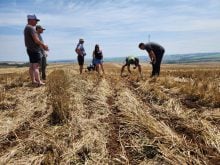Alberta rural municipal leader Don Johnson sounded elated when told of the news that the federal government is ready to start spending promised money on an expanding rural internet service.
“This is very positive,” he said from his southern Alberta farm Sept. 3 during a break from combining.
“We’ve been waiting for this for some time. It will be a real boost for rural Canada. There has been a period when we did not know how this was going to pan out and without information, it was frustrating.”
Read Also

Soybean market still figuring out implications of China-U.S. pact
Soybean futures had a muted reaction to the U.S. trade deal with China as the market tries to figure out the nuances of the deal.
The money was first promised more than six months ago in the winter budget when the Conservative government committed $225 million to rural internet service with Ottawa promising to cover up to 50 percent of infrastructure and start-up costs.
On Sept. 1, Industry Canada said it wants proposals by Oct. 23 from organizations willing to invest in rural broadband service. It will announce successful applicants by late 2009 or early 2010 with the infrastructure work to begin next year.
The Canadian Radio-television and Telecommunications Commission reported last year that while 94 percent of Canadian households have access to broadband service, the rural reality is just 78 percent.
Industry Canada said last week it hopes the call for matching funds from other organizations will help close the gap.
“The program will consider applications to provide service to as many unserved and under-served Canadians as possible, allowing them to participate in the digital economy by giving them access to information, services and opportunities that would otherwise be out of reach,” it said.
“For unserved and under-served Canadians, the program represents an important improvement in service.”
Johnson, president of the Alberta Association of Municipal Districts and Counties and chair of the Federation of Canadian Municipalities rural caucus, said he could not agree more.
He is uneasy that the Oct. 23 deadline leaves little time but he hopes that with the program in planning since last winter, proposals will have been developed already.
In Alberta, some natural gas distribution co-ops are interested in investing in broadband services. He expects across the Prairies there will be investment from provincial telephone companies and rural municipalities.
“In rural Canada, the economics often aren’t there because there aren’t enough users,” Johnson said. “And in a lot of cases, if the municipality doesn’t do it, it won’t happen in rural Canada. But I really think there is an opportunity for any and all people to look at 50 cent dollars.”
After the budget announcement of money for rural high-speed internet service, it became apparent that there was no clear understanding of where service was most lacking, a FCM official said last week.
Industry Canada investigated and created a “map” that indicates the Prairies and Atlantic Canada are regions least served.
In rural and remote northern Canada, service is quite good because of satellite access.
Johnson said he hopes there is strong interest in broadband investments with government financial help. A danger is that private investors will “cherry pick” areas where signals are strong and potential user base significant, leaving more remote or under-populated areas without service.














